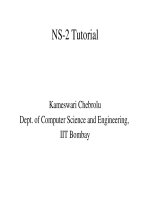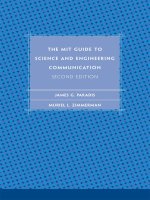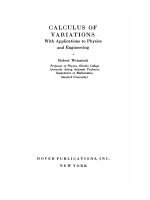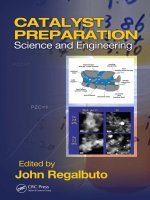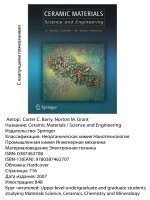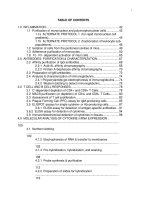MIT Guide to Science and Engineering Communication 2ed - J Paradis (MIT 2002) Episode 6 ppsx
Bạn đang xem bản rút gọn của tài liệu. Xem và tải ngay bản đầy đủ của tài liệu tại đây (586.76 KB, 25 trang )
Ask colleagues and supervisors about literature guides and types of
publications. Also check with reference librarians. For example, if re-
search reports from the Naval Research Laboratory in Orlando, Florida,
are possible sources, the NTIS database will be a useful literature guide.
If articles in the journal IEEE Transactions on Medical Imaging are im-
portant to your work, you might want to see what abstracts journals
abstract its articles.
As mentioned above, the Web resource JAKE (hjake. med.yale.edui)is
a useful tool for determining what databases index a particular journal.
Information about where specific journals are indexed is also provided in
Ulrich’s International Periodic als Directory located in the refer ence sec-
tion of your library. Ulrich’s is available in hard copy, CD-ROM, and
on-line formats (hwww.ulrichsweb.comi). As Figure 8.6 shows, IEEE
Transactions on Medical Imaging is indexed in more than a dozen dif-
ferent places. To trace a specific author, look in the author index of a
literature guide. Electronic searching is versatile. Your query goes di-
rectly to the electronic files.
Subject Searching Subject searching means using subject headings or
keywords to trace documents. With keywor ds, you can search either
titles or subject areas. You identify keywords in books, articles, or
thesauri. You then search the database, on-line catalog, or card cata-
log. Subject searches can be useful when you don’t know much about
the subject or when you just want to browse. Subject searching is also
an excellent cross-disciplinary approach because the cross-references
often show topical relationships between materials you don’t normally
associate.
In the sciences and applied sciences, however, the number of terms is
so vast and expands at such a rapid rate that you need to use thesauri
if you want to be accurate. In spite of its comfortable, encyclopedia-
like feel, subject searching is often not the best technique. It’s slow, even
on-line, and it often produces barren lists of documents with little rele-
vance to your interests. Subject searching on a Web browser can produce
thousands of listings.
Sometimes, you can address this weakness by using review articles,
reference guides organized by subject. Review articles identify and sum-
marize key articles and other publications that have contributed to the
Searching the Literature 115
Figure 8.6
Web page entries for two hulrichsweb.comi listings of the quarterly journal title,
IEEE Transactions on Medical Imaging: (a) general title search results, and (b)
document access. As shown in (b), more than a dozen abstracting and indexing
guides cover the articles published in this journal.
116 Searching the Literature
development of a specific field. Some review articles are broad surveys of
several years’ work. Others are state-of-the-art accounts of annual or
semiannual research. Review articles appear in standard refereed jour-
nals, in special review journals (e.g. Chemical Reviews), or in bound
volumes with titles such as Advances in or Progress in . . . Their un-
usually large numbers of references can help you identify review articles
in literature guides.
Snowball Searching The most widely used searching technique, the
‘‘snowball approach,’’ begins with a recent publication. You find a key
paper, preprint, review article, or textbook. Then you look up items
listed in the bibliography. From those retrieved item s, you look up fur-
ther entries, and so on, as Figure 8.7a shows.
The snowball search is fast and requires little use of literature guides.
You assemble a list of references that supply you with more references.
This technique does, however, have limitations. It tends to move you
back to literature that is obsolete, and if you begin with a marginal arti-
cle, you can spend much time assembling a network of similarly mar-
ginal papers.
Citation Searching In a citation search, you begin with a key source
paper and compile a list of papers citing that paper. The basis of your
search is that papers citing the source will be related. Just as the snowball
search moves you backward, the citation search brings you forward be-
cause the papers citi ng are more recent than the paper cited, as Figure
8.7b shows.
The crucial literature guide for citation searching is the Science Cita-
tion Index (SCI) of the ISI (see Table 8.1). It is available in hard copy,
on-line (The Web of Science), and on CD-ROM. The SCI consists of a
citation index that lists the authors cited in footnotes and bibliographies
of selected journals and books and a source index that lists authors of all
citing publications. Covering a core of more than 5,700 journals, the SCI
manages to account for a considerable percentage of the articles cited in
basic science and applied science.
Citation searching offers distinct advantages. Like the snowball
method, the citation search moves directly from document to document,
with no intervening terminology or subject indexes. But the journals it
Searching the Literature 117
Figure 8.7
Two reference searches. The snowball search (a) moves the search back in time.
An article by Douglass in Physical Review Letters (1961) takes you back to Nicol
et al. (1959), Gaiver (1957), and Bardeen (1954). The article by Bardeen in the
Physical Review is a review article with 39 references. In this way, you quickly
find background literature and build a network of references. The citation search
(b) moves you forward in time. Six different articles cite a source paper by Haus,
which appeared in the IEEE Journal of Quantum Electronics in 1975. A more
recent paper by Ho in Electronics Letters brings you forward to 1979.
118 Searching the Literature
covers are only part of the published literature. In addition, citation pat-
terns are more significant in some fields than others. Citation searching
has limited applications to engineering, private sector science, and for-
eign publication.
‘‘Star’’ Searching With the ‘‘star’’ approach to searching, you look at
certain star journals, researchers, or institutions that often account for a
high proportion of the important publications and know-how in a spe-
cialized area. If you monitor their output, you will find crit ical work
done in a given field. This approach offers focus.
To follow key journals, go to back issues, skim the article titles and
abstracts, and glance over the cumulative subject indexes. To follo w
key authors, turn to the cumulative author indexes of journals or litera-
ture guides. You can also follow the research output of a facility known
for its special work. For example, if a type of pol ymer research is being
carried out in the materials science department of MIT or Stanford, you
can track that research in the corporate index of Chemical Abstracts .
Corporate indexes are standard features of many literature guides. Key
authors and institutions may be searched together.
Comprehensive Database Searching You can carry out comprehensive
database searches from a computer linked to one or more commercial
database systems such as those listed in Table 8.1. You focus the search
by using thesauri to develop a search profile of terms that will draw the
desired information from the database. The Gale Directory of Databases
is a semiannual publication which lists several hundred databases that
cover many technical fields and special forms of literature such as re-
ports, theses, and patents. Using these databases can be intimidating and
time consuming. The operation may require the assistance of a reference
librarian and may be conducted most effectively on a fee-for-service basis
with the help of an information specialist. However, more and more
user-friendly Web-based access is provided to support direct end-user
searching.
Normally, the initial search profile needs to be tried out and focused
until relevant titles and abstracts show on the screen. Add terms to nar-
row the search. Delete terms to broaden it. Database searching is use-
ful when you need to compile a bibliography, gain access to restricted
Searching the Literature 119
databases, or find recent bibliographical information before it appears in
literature guides. The sheer time required to read and assess the results of
this kind of search, however, can be significant.
Running the Search
Searches rarely go according to plan, so you need to combine planning
with initiative. You might begin, for example, with one or two papers
furnished by a colleague, retrieve selected references listed in those
papers, and then refer to a literature guide that indexes journals in which
the most interesting papers appear. The key terms in the literature guide
may help you modify your own list of keywords. If you find a valuable
author, you might look in the literature guide’s author index to see what
else that author has published. Examine the corporate index to see if the
author’s research group is producing other papers on the subject. You
might also glance at the SCI to see what other publications have cited
your key papers.
When you have compiled a list of potential papers, you need to re-
trieve them. Thi s process can be time consuming. Examine the abstracts
of the papers carefully to see if you really need the complete work.
Papers on topics close to your own research may be especially important
if you’re in danger of duplicating the research of others. Photocopy and
collect important papers. Note other references of limited interest. Keep
your notes up to date.
Current Awareness Searching
Because advances and innovation are the lifeblood of scientific profes-
sions, staying informed is critical. The best way is through routine, in-
formal oral exchanges with colleagues, as well as peer group discussions
at professional and trade conferences. Formal current awareness search-
ing, by contrast, can keep you abreast of developments outside your cir-
cle of acquaintances. It also requires special literature guides.
One simple but useful tool is the contents journal, which prints the
contents pages of recent professional journals. Current Contents, a series
of small biweekly contents journals published in hardcopy and electronic
formats by the ISI comes in different specialized fields. One is the Physi-
cal, Chemical, and Earth Sciences Edition. Another, the biweekly publi-
120 Searching the Literature
cation of Chemical Abstracts Service, called CASelects, covers over 1,000
journals. All the information vendors listed in Table 8.1 offer extensive
current awareness services, which are described at their respective Web
site URLs.
A related service is the published search. Many information vendors
publish prepared searches, each based on a set of keywords that iden-
tifies specific subjects of interest. These bibliographies may be ordered
directly from the vendor (see Table 8.1).
Information Vendors
Information is now a commodity, and big information vendors offer
a variety of services. The most specialized (and expensive) are the Selec-
tive Dissemination of Information (SDI) services, which tailor searches to
the individual purchaser. SDI services, offered by most information ven-
dors, periodically match a database to search keywords provided by the
purchaser. The resul ts are mailed or transmitted electronically. These
services are also available for new patents, government standards, and
military specifications.
Available services include
.
Published reference works such as abstracts and index journals, bib-
liographies, and other compilations
.
Current-awareness services, including contents journals and SDI
services
.
General and specialized databases available for on-line searching
.
Document-on-demand acquisition services by e-mail, telephone, and
Services available from nine information vendors are listed in Table
8.1. Each vendor supplies literature and maintains a Web site that out-
lines specific services. Two even larger information vendors that market
thousands of information products, including many of those listed in
Table 8.1 and elsewhere in this chapter, are Ovid Techno logies (hwww.
ovid.comi) and Dialog, a subsidiary of the Thompson Corporation
(hwww.dialog.comi ).
Searching the Literature 121
This page intentionally left blank
9
Documenting Sources
Preparing Citation and Reference Sections
Citing References in Texts
Preparing a Reference List
Citing Sources for Tables and Figures
Citing Electronic Information Sources
Paraphrasing and Quoting Ideas from Sources
Paraphrases
Short Direct Quotations
Long Direct Quotations
Partial Direct Quotations
Altered Quotations
Managing Citations and References
o
You have agreed to write the literature review for the proposal your
work group is about to finish. Your job will be to summ arize the earlier
research that has led the principal investigator to frame the question and
apply for research support. You know the science involved, and you’re
familiar with 10 years of technical literature. The content should be easy.
But now that you begin to write, you wonder how much to quote, how
much of the summary is so basic that it needs no references, and what
reference style to use.
Proposals, reports, and journal articles almost always contain references
to earlier published work. If you have done a good job of researching
your subject, the quality and quantity of the sources you have con-
sulted will enhance your work. Your work acquires credibility when you
review the literature and show that your contribution extends from a
solid foundation of respected research.
In citing sources and preparing an accurat e reference section, you
make it possible for readers to retrace your steps by locating and con-
sulting the papers that informed your work. They may wish to assess
your work in the light of previous contributions to the subject, or they
may be reading for ideas to help them with new or continuing projects.
Preparing Citation and Reference Sections
In reporting the results of a literature review, you have two tasks. For
one, you need to write citations to the earlier work you are reporti ng.
These citations appear in the text, at the place where you have referred
to the earlier work. For the other, you must prepare a reference section
or bibliography with specific details about authorship, publication, edi-
tions, and dates for each citation. Reference sections appear at the end of
the document.
In scientific an d engineering fields, variants of two citation styles and
at least one hundred reference styles are commonly used. The appro-
priateness of each is determined solely by the expectations of potential
readers. Use whatever style you choose consistently throughout a docu-
ment, but know that the particulars of style are established by conven-
tion and group practice. Even within specific fields, however, a variety
of styles may be permitted. The American Chemical Society, for ex-
ample, allows three forms of citations in ACS publications (superscript
numbers; italic numbers on the line, in parentheses; author name and
year in parentheses).
Find out if style guidelines are available in your work setting or pro -
vided by your anticipated audience. If you are submitting an article for
journal publication, check the journal for advice about preferred refer-
ence style. Consider purchasing the style manual of your professional
society. The American Chemical Society, American Mathematical Soci-
ety, American Medical Association, American National Standards Insti-
tute, American Institute of Physics, and the Council of Biology Editors
are some of the groups that publish guidelines for authors. Many of
these organizations provide extensive information on their Web sites.
124 Documenting Sources
Several software packages are available for managing references. You
create a database entry for each item, storing biblio graphic information
such as author, title, date, publisher, place of publication, volume, num-
ber, and page. When you prepare the citations and reference section, you
can choose from a menu of styles, and the software will automatically
format your paper. If you revise your paper for a publication with dif-
ferent documentation standards, the software will reformat as necessary.
Citing References in Text
In scientific and engineering writing, two broad styles are commonly
used for citing earlier work. In one style, the author’s name and year of
publication are printed in the text, enclosed in parentheses (see Figure
9.1a). The other style is based on a number, sometimes set on the line in
parentheses or square brackets, sometimes set in superscript format (see
Figure 9.1b). If the number appears in superscript format, it usually (but
not always) refers to a footnote or endnote rather than to an item in a
reference list. In each case, the citation refers to more complete biblio-
graphical information provided in a footnote or at the end of the docu-
ment in the reference section.
If you are free to select a style for your in-text citations, consider these
comparative features. Many readers prefer author’s name/year of publi-
cation citations in a literature review. When names and dates are em-
bedded in the text, readers immediately know what researchers you have
consulted and can assess the currentness of your search. Numbered ref-
erences do not intrude on the text, so they are easier to skip over if you
are reading strictly for research findings. If they are handled sequentially,
though, numbered references may present problems when you add or
delete anything.
Preparing a Reference List
The precise bibliographic form for items in your reference list will be
established by the style guide you select. For author’s name/year of pub-
lication citations, references appear in alphabetical order. For numbered
citations, references usually appear in the order in which you have re-
ferred to them, though some journals prefer alphabetical order in these
cases as well.
Documenting Sources 125
Figure 9.1a
Author’s name and year of publication. In this citation style, the author name(s)
and year of publication appear in parentheses in the body of the paper, and each
citation links to a reference section at the end of the paper. Within this general
style, you will find a range of variations. Some journals require square brackets
rather than parentheses; some require a comma between name and date; some list
first author only; some list up to three authors.
126 Documenting Sources
Figure 9.1b
Numbered citations. In this citation style, each number refers to an item in the
final reference list. Numbers are almost always enclosed in square brackets rather
than parentheses, to distinguish citations from equations.
Documenting Sources 127
If you have no other instructions to follow, some typical bibliographic
forms are provided below. Note that personal communications and other
forms of ‘‘nonrecoverable’’ information such as interviews or phone con-
versations are usually not included in the reference section, though they
may have been mentioned in the body of the article. Distinguish multiple
items publis hed by one author in the same year with lowercase alpha-
betic letters: (Wilde, 1997a; Wilde, 1997b).
Book. McClinto ck, F. A. and A. S. Argon. 1966. The mechanical behav-
ior of materials. Reading, MA: Addison-Wesley.
Journal article. Ulmer, B. and H. Ishii. 2000. Emerging frameworks for
tangible user interfaces. IBM systems journal. 39: 3:915–931.
Article in an edited collection. Engelbart, D. C. 1960. A conceptual
framework for the augmentation of man’s intellect. In Computer-
supported cooperative work, edited by I. Greif. San Mateo, CA: Morgan
Kaufmann Publishers.
Report. Winward, A. H. 2000. Monitoring the vegetarian resources in
riparian areas. Report No. RMRS-GTR-47. Ogden, UT: U.S. Depart-
ment of Agriculture.
Dissertation or thesis. Cavallo, D. 1996. Leveraging learning through
technological fluency. Master’s thesis. Massachusetts Institute of Tech-
nology Media Laboratory.
Conference paper in proceedings. Fettwels, A., and M. Nossek. 1981.
Sampling rate increase and decrease in wave digital filters. Proceedings,
6th IEEE symposium on circuits and systems, 839–841. Chicago, IL:
Institute of Electrical and Electronic Engineers.
Patent. Gershenfeld, N. September 21, 1993. Method and apparatus for
electromagnetic non-contact position measurement with respect to one
or more axes. U.S. Patent No. 5,247,261.
Standard. American Society for Testing an d Materials (ASTM). 1979.
Standard for metric practice. PCN 06-503807-4l.
Citing Sources for Tables and Figures
If you photocopy, scan, or otherwise reproduce a figure or table from
another publication for inclusion in your document, you must credit the
source. Even if you redraw the illustration but borrow significantly from
the original, you need to cite the original author and publication. Refer-
ences to figures and tables can be identified by the word source (usually
128 Documenting Sources
in small capital letters) and treated as an integral part of the artwork
(Figure 9.2).
Citing Electronic Information Sources
Though technology has advanced more rapidly than bibliographic prac-
tice, reference conventions have emerged for information gleaned from
electronic media. The purpose of any reference section remains the same:
to enable readers to locate and examine all documents referred to by the
authors, including those that exist only as computer files.
In citing an electronic publication, your goal is to help readers to re-
trace your steps if they choose. Title, author, and date the material was
written are crucial pieces of information, as they are in hard copy. It is
helpful to include the publication medium (on-line database or CD-
ROM, for example) and the name of the vendor or on-line publication
service. But you will have to be flexible in the information you provide.
Figure 9.2
When tables and figures are reproduced from their original sources, the source is
identified directly under the caption. In most cases, the original caption needs to
be rewritten for its new context.
Documenting Sources 129
Details are not always available. Though a scrupulous Web site should
include a page with month and day when it was last updated, such in-
formation is not always provided. For that reason, some researchers also
include the date when they accessed the site referred to which they refer.
In general, personal e-mail is considered ‘‘nonrecoverable’’ information
and is not included in a reference section, though it may have been
mentioned in the text.
Abstract of a journal article from a database. Longo, N. and S. Langley,
L. Griffan, and L. Elsas. M ay, 1995. Two mutations in the insulin re-
ceptor gene of a patient with leprechaunism. Journal of clinical en docri-
nology and metabolism, 80 (5) [Online abstract]. Medline Plus, National
Library of Medicine. Item: UI 95263703.
Article from an electronic journal. Bhandarkar, S. V., and S. H. Neau.
December 15, 2000. Lipase-catalyzed enantioselective esterification of
flurbiprofen with n-butanol [On-line jou rnal]. EJB Electronic Journal of
Biotechnology, 3 (3). Available: />full/3/.
CD-ROM. Aquatic Sciences and Fisheries Abstracts 1988–1994. [CD-
ROM] Cambridge Scientific Abstracts. Compact Disc SP-160-010. Silver
Platter. Available: .
Computer program. EndNote 4 (Word for Windows 2000 compatible
format). [Computer program]. ISI ResearchSoft. Available: http://www.
endnote.com.
Web site. V. Gerasimov and W. Bender, Swings that think. Retrieved
April 21, 2001 from the World Wide Web: .
edu/stt/bat.html.
Paraphrasing and Quoting Ideas from Sources
Even in documents explicitly designated as literature reviews, technical
authors do not usually quote extensively from their sources. Rather, they
summarize key points, restating ideas in their own words. However,
whether you quote exactly and enclose the borrowed phrases or sen-
tences in quotation marks or you restate and summarize in your own
language, you must still credit the source. Only when the ideas and in-
formation are considered common knowledge can you omit a citation. A
simple test of whether ideas are common knowledge is this one: Wou ld
130 Documenting Sources
this idea or piece of information be familiar to someone with your aca-
demic and professional standing (perhaps a colleague) who has not
researched the subject? If the answer is yes, you do not have to cite the
source. Otherwise, you must indicate the source of the material, even if it
appears in several texts.
Paraphrases
When you paraphrase, you restate ideas in new forms that are original in
both sentence structure a nd word choice. Taking the basic structure from
a source and substituting a few words is not an acceptable paraphras e
and may be construed as plagiarism. Similarly, creati ng a new sentence
by merging the wording of two or more sources is also unacceptable.
For the long direct quotation presented in Figure 9.3, the following
restatement is not acceptable as paraphrase because it is too close to the
original: Electric-field nulling reduces unwanted hot spots in or on the
target body; electric-field focusing maximizes the delivered RF power.
These goals can be achieved by using an adaptive hyperthermia phased-
array system (Fenn and King 1992, 236) .
Here is an acceptable paraphrase:
During heating of a tumor site, an adaptive hyperthermia phased-array
system can achieve two important clinical goals: reduced incidence of
unwanted hot spots and improved pow er delivery (Fenn and King 1992,
236).
Note tha t both the sentence structure and some of the wording have been
changed, so that quotation marks are unnecessary.
Short Direct Quotat ions
If a quotation occupies four lines or fewer in your manuscript, incorpo-
rate it in your text and use quotation marks to indicate where your
words stop and the quotation begins. In the author/date format, provide
a page number within the parentheses:
Both electric-field nulling, which reduces the ‘‘occurrence of undesired
hot spots inside or on the surface of a target body,’’ and electric-field
focusing are ‘‘intended to maximize the RF power delivered to a tumor
site’’ (Fenn and King 1992, 236).
Documenting Sources 131
Figure 9.3
Long direct quotations are set off from the text, without additional quotation
marks.
132 Documenting Sources
Long Direct Quotat ions
If a quotation is five lines or longer, set it off from the text by beginning a
new line and indenting one inch from the left margin as shown in Figure
9.3. Do not use quotation marks. If you are using author/date citation
style, provide an exact page reference.
Partial Direct Quotations
Use ellipsis marks, usually three spaced periods, to indicate any deletions
you have made in the quotation:
Fenn and King have demonstrated ‘‘electric-field nulling . . . to reduce the occur-
rence of undesired hot spots inside or on the surface of a target body . . . and
electric-field focusing . . . to maximize the RF power delivered to a tumor site’’
(1992, 236).
Altered Quotations
Use square brackets to mark any alterations you have made to the quo-
tation. In the following exampl e, the author is quoting directly from
Fenn and King’s paper, but she has added to the original source an ex-
planation of the abbreviation RF:
Fenn and King have demonstrated ‘‘electric-field nulling . . . to reduce the occur-
rence of undesired hot spots inside or on the surface of a target body . . . and
electric-field focusing . . . to maximize the RF [radio frequency] power delivered
to a tumor site’’ (1992, 236).
Managing Citations and References
Researchers frequently reuse reference sections in continuing projects,
building on earlier library and database searches as they enter new
phases of their work. If a paper is rejected by one journal, they may
submit a revised version to another journal with different documentation
requirements.
Maintain complete bibliographic information about each cited item so
that you can modify a reference section if necessary, without spending
valuable time looking up details like beginning and end page numbers
or the full names of coauthors. Develop a process for keeping it all
together, whether you use software specially designed for such tasks,
Documenting Sources 133
adapt a database program for the purpose, or create your own scheme
for maintaining complete bibliographic information.
Reference sections often interest readers long after the research
methods reported in the article have been superseded by new approaches.
A good reference secti on provides access to the history of a technical
problem. Your references can be as valuable as your research methods
and findings.
134 Documenting Sources
PartII
10
Memos, Letters, and Electronic Mail
The Difference between Memos and Letters
Reaching Your Audience
Brevity and Focus
Design for Emphasis
Memos
Memo Format
Memo Organiza tion
Memo Style
Letters
Letter Format
Letter Organization
Letter Status
Electronic Mail
Reaching Your E-Mail Audience
Evolving Conventions
The Status of E-Mail
Memos and Letters as Part of a Continuum
o
As the newly hired pr oject manager for a software design team, you
spend your first days on the job reading the files. You have little time to
interview team members and ask follo w-up questions. By the end of your
first week, you must report to your manager with a detailed proposal
and work plan for a stalled project. Your assessment of both the history
of the project and the roles played by the engineers in your group will be
based on your review of archived e-mail. Team members’ correspon-
dence will form your first impressions.
Memos and letters are brief and relatively informal documents, yet many
technical professionals spend more time writing (and reading) these fa-
miliar forms, in hard copy or as electronic mail, than they spend on any
other communication task. Despite their brevity and relat ive informality,
memos and letters may be archived and reviewed later, often by those
not originally addressed. Both forms may become important parts of a
project record. They may serve as the basis for important decisions, with
effects as significant as those of multivolume proposals or articles pub-
lished in prestigious journals.
The structure of both memos and letters is flexible enough to be useful
for a wide variety of purposes, including proposals, requests for infor-
mation, trip reports, complaints, inquiries, records of telephone conver-
sations, or calls for meetings. The personalized forms of memos and
letters distinguish them from other technical workplace documents. They
name the recipient, they name coreci pients, and they identify the author.
In recent years, e-mail has dramatically increa sed the correspondence
workload for many engineers and scientists. E-mail has blurred distinc-
tions between the traditional memo and letter forms, opened new com-
munication channels, and changed the way that information flows in
many organizations.
The Difference between Memos and Letters
The memo form is used for communi cating within an organization,
never for an outside audience. The letter is used for communi cating out-
side an organization. Thus a feasibility report prepared for exclusive use
within a company will be accompanied by a memo of transmittal, and a
report prepared for a client will be covered by a letter of transmittal.
Social practices will vary, of course. A supervisor wanting to congratu-
late an engineer for having a paper accepted for publication might send a
letter to a home address, rather than a memo through the interoffice
mail.
In e-mail communication, no distinction is made between memo
and letter or between files that will be transmitted to the next office and
files that will be transmitted across the country or around the world.
E-mail written to a colleague in the next office looks exactly like e-mail
138 Memos, Letters, and Electronic Mail
written to a client on another continent. Gone are the social signals and
organizational images communicated through letterhead. You, under
your user name, write to someo ne else with a user name. All user names
are more or less the same length, without clues to educational or profes-
sional status. Most e-mail recipients open their own mail—even those
who never read hard copy memos or lett ers until a secretary has opened
envelopes and logged in each document. Most e-mail readers answer
their own mail—even those who otherwise dictate copy for secretarial
transcription.
Reaching Your Audience
In shaping the content of memos and letters, you must address the in-
formation needs of your recipient. In your search for a persuasive strat-
egy, consider what your reader already knows about the situation you
are addressing. Ask yourself how this reader is likely to react to what
you are saying. Then remember that the first audience for memos and
letters may not be the last. If copies of your document need to be sent to
other readers, you should also consider how each one is likely to respond
to what you have written.
Brevity and Focus
Though memos and letters are frequently many pages or screens long, we
recommend using these correspondence forms for brief accounts of single
issues, with a goal of one-subject, one-page (or one-screen) for each
document. The subject should be specified in the subject line, and the
content should relate to the stated subject. For two subjects, write two
documents. In that way, each subject can receive your reader’s full
attention, and each document can be appropriately filed for retrieval at
a later date. Realistically, the conventional format of letters requires so
much space for formalities that it is often difficult to hold to a one-page
limit. Nonetheless, we recommend brevity.
Design for Emphasis
For hard copy memos and letters, visual presentation is crucially impor-
tant: memos look like memos; letters look like letters. But faithfulness to
Memos, Letters, and Electronic Mail 139

